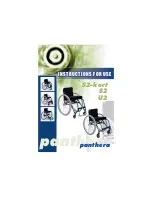
Instructions for use U2, S2, S2-short
Instructions for use U2, S2, S2-short
7
6
8
5
6
5) Tension of the backrest upholstery
The back upholstery can be tightened or loosened by adjusting the Velcro band at
the back. The back upholstery also has a fl ap fastened with Velcro under the seat
upholstery. This can be moved back or forwards to obtain the required tension in
the lower section of the back upholstery (known as the seat bucket). By adjusting
these things you can form the lower part of the back upholstery to suit the shape
of your back and obtain good support for your lower back. Start by loosening the
band and sit as far back in the chair as you can. Then tighten the band to give you
good support. If it feels as though you are not sitting far back enough in the chair it
may be because the back upholstery fl ap is fastened too far forward under the seat.
Relax this fl ap and move it back.
Figure 6.
Balancing.
6) Balancing the wheelchair
The balance of the wheelchair can be adjusted by moving the rear wheels back or
forwards depending on how much ‘rear balance’ you require. The chair will be
lighter at the front with more weight over the rear wheels. This makes the chair
easier to manoeuvre and it will also be easier to tip up onto the rear wheels, for
instance, when negotiating curbs, thresholds and so on. The chair should not be ba-
lanced too far to the rear because this will increase the risk of tipping backwards. It
is important that you take time trying out a balance that suits your body and driving
techniques so that you adapt the chair to be as easy to drive as possible, without
increasing the risk of tipping backwards too much. You should always have so-
meone standing behind you when you try out the chair after adjusting the balance.
If you still feel unsure about the balance of your chair having tested it thoroughly
you should use anti-tips (accessory). The anti-tips eliminate the danger of tipping
backwards and they are easily removed when you no longer need them.
How to move the rear wheels:
Remove the rear wheels.
Loosen the nut casings (6) with the 22 mm cap key, and the nut to the wheel
attachment (7) using the 15 mm cap key on both sides of the chair.
You will now be able to push the wheel attachment (8) forward or back along
the horizontal frame tubing. It is important that you have the wheel attachment
in the same forward position on both sides of the chair. You can check this by
measuring the distance between the forward section of the vertical tubing and
the rear section of the wheel attachment as shown in fi gure 6 using a tape mea-
sure or ruler, and check that the distance is the same on both sides.
Tighten the wheel attachments. When you tighten the wheel attachments you
should always fi rst tighten the nuts (6) on both sides, and then tighten the M10
nuts (7) on both sides. This sequence is important to ensure that the wheel at-
tachments are positioned correctly.
1.
2.
3.
4.


























